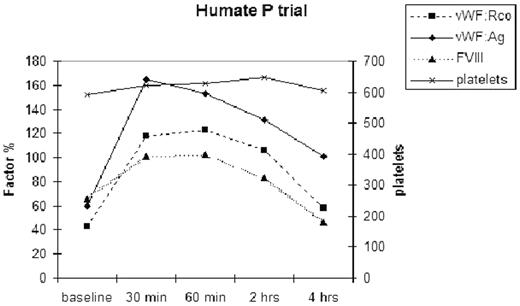Abstract
The patient is a 16 year old boy with a past medical history of atrial septal defect and juvenile migraine headaches. He had no unusual bleeding or bruising during his early childhood including circumcision. His family history was negative for bleeding diasthesis. At the age of 12, he was diagnosed with an intramuscular hematoma on MRI after a baseball injury. Four months later he had heavy bleeding after an accidental knife wound to his hand, requiring repeated suturing. At age 14, he had another intramuscular hematoma after baseball injury, impairing range of motion in his leg. At age 15, following another deep muscular hematoma,, he underwent a laboratory evaluation for the first time. His CBC was normal except for a platelet count of 1,216,000/μl and he was subsequently diagnosed with ET. He had an elevated PTT, with a normal PT. He had a FVIII level of 42%, vWF Ag of 43%, and vWF:RCoF < 20%. Multimer analysis showed relatively decreased to absent large multimers. To evaluate optimal treatment, a Stimate (DDAVP) challenge, as well as a vWF-containing concentrate (HumateP) infusion study were performed:
Stimate (DDAVP) trail
Humate P trail
The patient demonstrated a good response to DDAVP, with greater than 2-fold baseline levels of FVIII and VWF:RCo persisting after 4 hours. Multimer studies showed increases of low and intermediate multimers after administration of DDAVP. Following infusion of Humate P (53 vWF:RCo U/kg), VWF:Ag levels increased appropriately; however, VWF:RCo and FVIII levels increased to a lesser extent and fell to baseline by 4 hours. Platelet counts remained stable with both Stimate and Humate P. These results suggest that the patient’s platelets have an especially high affinity for high molecular weight (HMW) multimers, explaining the lack of HMW multimers on baseline analysis in this patient. The shortened response duration following Humate P infusion suggests rapid clearance due to platelet binding of the larger (and more functional) multimers contained in the concentrate. The longer duration of response to DDAVP, which releases his own low and intermediate multimers (but not HMW multimers) into circulation, indicates that DDAVP may be a superior treatment option in patients with AVWS associated with ET.
Disclosures: Dr Leissinger has been a consultant to ZLB Behring in the last 2 yeas.



This feature is available to Subscribers Only
Sign In or Create an Account Close Modal